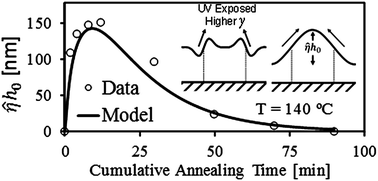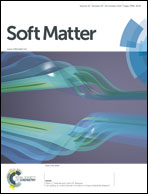Precision Marangoni-driven patterning†
Abstract
A Marangoni flow is shown to occur when a polymer film possessing a spatially-defined surface energy pattern is heated above its glass transition to the liquid state. This can be harnessed to rapidly manufacture polymer films possessing prescribed height profiles. To quantify and verify this phenomenon, a model is described here which accurately predicts the formation, growth, and eventual dissipation of topographical features. The model predictions, based on numerical solutions of equations governing thin film dynamics with a Marangoni stress, are quantitatively compared to experimental measurements of thin polystyrene films containing photochemically patterned surface energy gradients. Good agreement between the model and the data is achieved at temperatures between 120 and 140 °C for a comprehensive range of heating times using reasonable physical properties as parameter inputs. For example, thickness variations that measure 102% of the starting film thickness are achieved in only 12 minutes of heating at 140 °C, values that are predicted by the model are within 6% and 3 min, respectively. The photochemical pattern that directed this flow possessed only a 0.2 dyne cm−1 variation in surface tension between exposed and unexposed regions. The physical insights from the validated model suggest promising strategies to maximize the aspect ratio of the topographical features and minimize the processing time necessary to develop them.


 Please wait while we load your content...
Please wait while we load your content...